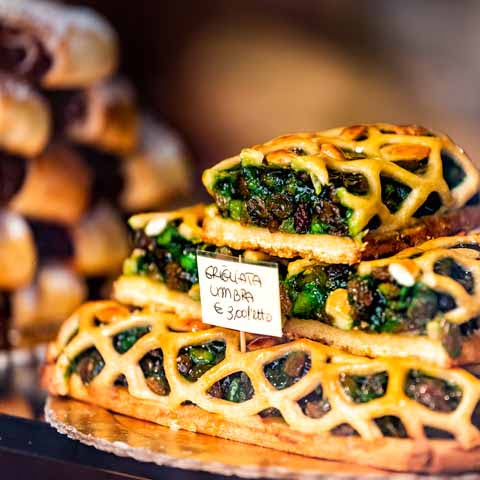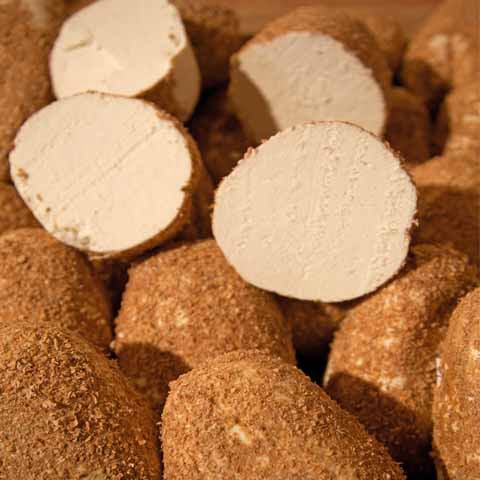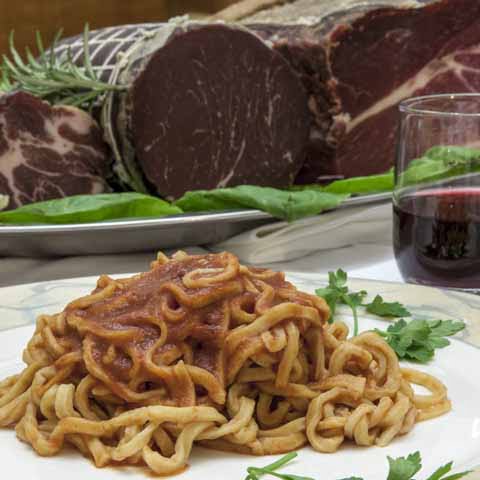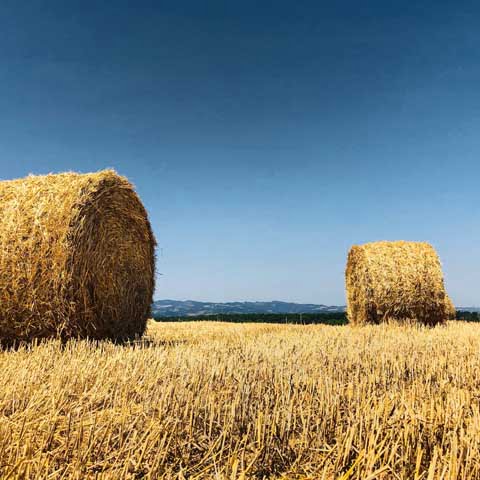Orvieto is truly a hidden gem among the various destinations around Italy. While many larger cities tend to attract more tourism, people who visit Orvieto are always thrilled by the number of truly unique experiences that can only be encountered in the city, including a wide range of cuisine to enjoy that is distinct from anywhere else in Italy.
The people of Orvieto use all kinds of novel and local ingredients in their cuisine that are native to this part of Italy. For example, one of the most traditional meats served in Orvieto is pigeon. Pigeons and doves have been raised for food in Orvieto dating back to the Etruscan period. The most classic way to cook pigeon is to slow cook it rotisserie style with added ingredients such as olives, garlic, lemon, pepper, capers, sage, and more. It is then served with bread and sauce made from its own drippings. This dish is called Palomba alla Leccarda and it is one of the town’s most iconic dishes. Other staple ingredients here include white truffles, extra virgin olive oil, chestnuts, mushrooms, local cheeses, pork and cured pork, poultry, and wild game.
Orvieto is also well-known as a winery town, with its winemaking traditions dating all the way back beyond Roman times and into the Etruscan period. Ancient frescoes depict the Etruscans holding grand banquets with massive pitchers of wine. When Orvieto was controlled by the papacy, many popes owned palaces in the city and savored the region’s wine. In fact, the popes throughout history loved Orvietan wine so much that it came to be known as “Il Vino dei Papi,” or the Wine of the Popes. Even to this day, wine remains the economic center of Orvieto, and some of the most beloved wines are produced here.
APPETIZERS
The people of Orvieto particularly enjoy two well-known appetizers: bruschetta and crostini. Both are slices of bread that have been toasted or grilled and topped with delectable ingredients. Bruschetta is usually made with larger, coarser pieces of bread, and is traditionally toasted over hot coals. Bruschetta is generally drizzled with olive oil and topped with fresh or marinated vegetables, such as tomatoes, basil, chopped artichoke hearts, and other more mildly flavored vegetables.
Crostini on the other hand are much smaller, and usually made with finer-textured breads. Crostini tend to be topped with much more intensely flavored toppings such as capers, goat cheese, olive paste, anchovies, and chopped wild mushrooms.
Local cuts of meat, such as prosciutto and salame, are served before a meal, and sometimes alongside crostini. Pork meat features abundantly in Orvieto’s cuisine with locals finding a use for all pork cuts. One cut of meat that is highly traditional to Orvieto is mazzafegati, or pork liver sausage.
Local cheeses may accompany the appetizer as well, and among the most typical is Cenerino. This ancient sheep’s milk cheese is produced following traditional techniques that include a two-step aging process. During the first step, the cheese is aged under ash for three months and in the second step it is aged for four months in terracotta containers. The result is a unique cheese with a sharp taste that can vary slightly based on the wood used in the first step of the aging process.
FIRST COURSE
First courses in Orvieto generally feature one of two types of dishes: soup or pasta.
The townsfolk of Orvieto particularly favor a local chickpea soup called zuppa di ceci e castagne. The chickpea soup is made with garlic, tomato, and sage, and is often served with local chestnuts. It is then seasoned with rosemary to give it a delightful aromatic quality. One variation of the soup replaces the chestnuts with gnocchi, or potato dumplings, while others prefer the simple flavor of the chickpea soup without any additional ingredients.
Much like other places in Italy, one cannot go wrong ordering pasta when visiting Orvieto. The people of Orvieto have many traditional pasta dishes to offer. Perhaps the most iconic pasta shape in this city is umbrichelli. Umbrichelli is a long pasta, similar to spaghetti or linguine, but significantly thicker and handmade with a simple dough of flour and water. This pasta was invented in the Orvieto area and is often served all’arrabbiata, that is, in a tomato sauce made with chili peppers, giving it a distinctly spicy kick. For visitors who do not favor spicy food, though, it can also be served with a truffle sauce as umbricelli al tartufo, instead.
Other pasta dishes found in Orvieto are such delights as tagliatelle al ragù, which is a handmade ribbon pasta served with a meat sauce, and spaghetti con il tonno, or spaghetti with tuna.
SECOND COURSE
Perhaps the most traditional meats served in Orvieto are the above-mentioned pigeons and doves. When visiting Orvieto, it would be a shame to miss out on trying the traditional palomba alla leccarda at least once.
The people of Orvieto also favor other kinds of meats. Rabbit is often served in Orvieto and typically is roasted with plenty of herbs including wild fennel and rosemary. But perhaps the most common meat found in this region is pork.
The pork in Orvieto can be loosely defined down to two categories: farm raised pigs, and wild boar. Both are served differently in Orvieto. Farmed pork, like rabbit, is often served roasted with wild herbs, or is cut into sausages and other cold cuts. Wild boar, on the other hand is often served grilled or served in a variety of thick, hearty stews and sauces. There are many different pork dishes served in the city and all are delightful.
A common poultry dish in Orvieto is gallina ‘mbriaca, which translates to drunk hen. To make the dish, the hen must be marinated in wine for at least one night. Then it is cooked in wine before being served.
CONDIMENTS AND SIDE DISHES
Along with its traditions of making wine, Orvieto also has a rich history of making olive oil. The grassy hills surrounding the town make the perfect, fertile soil to cultivate olive trees, and many dishes in the city are cooked with or served alongside locally grown extra-virgin olive oil.
Side dishes here consist of locally grown in-season vegetables that may be roasted, steamed, or sauteed. The flavorful local mushrooms may also be enjoyed as an accompaniment to dishes in Orvieto.
STREET FOOD
The most traditional street foods found in Orvieto are biscuits known as tortucce and lumachelle. Tortucce is a simple biscuit made from a dough of fresh flour and seasoned with salt and rosemary. Traditionally, tortucce were made with the very first flour that was ground in the harvest season, to ensure the quality of the crop.
Lumachelle are perhaps the most favored of all Orvietan biscuits, though. These rolls are served as appetizers or street foods, and are shaped in little spirals, similar to American cinnamon rolls. In fact, the name lumachella means “small snail” in reference to the spiraling shape of the roll looking like a snail’s shell. It can be served hot or cold, sweet or salty, in any situation. Generally, though, lumachelle are flavored with savory ingredients such as olive oil, pecorino cheese, salt and pepper, bacon, lard, or prosciutto.
DESSERT
Compared to other places in Italy, which largely seem to favor cakes and pies, the people of Orvieto favor cookies, particularly tozzetti and cantucci. These double-baked cookies are made with various flavoring herbs and nuts. Tozzetti are native to the Umbria region and are typically made with hazelnuts, though a variety of other ingredients may be added, such as chocolate, pistachios, or pine nuts. Cantucci, on the other hand, were invented in Tuscany, and a standard recipe of anise and almonds is widespread throughout Tuscany and much of Italy. In either case, both of these cookies are traditionally enjoyed with a sweet Vin Santo wine.
Another cookie often found in Orvieto is ciambelle al vino, or the sweet Italian wine cookie. These cookies have a mild sweetness to them and are quite crunchy. They are usually shaped like little doughnuts and may have a dusting of powdered sugar over them. Traditionally, ciambelle al vino are served alongside dessert wines.
Often served with these cookies, or occasionally simply alongside chunks of chocolate, is a liqueur that is highly traditional to Orvieto: Svinnere. Made from local wines and sweetened with wild cherries, Svinnere is a must-try.
The locals also have two special desserts that are made for religious holidays. One recipe is Frittelle di San Giuseppe, which consists of rice and milk balls sweetened with sugar made on March 19 for the Feast Day of St. Joseph, the patron saint of Orvieto. The other is Pizza di Pasqua, a special yeast bread prepared for Easter Sunday and Easter Monday.
WINE
Winemaking is perhaps the most traditional business in Orvieto, and the town has a long and storied past of making famous and flavorful wines that even the popes throughout history favored. To this day, Orvietan wine is served far and wide, and the local wine has achieved DOC status. The most classic version is a white wine, but red and rosé varieties are produced as well.
The Orvieto Classico is a white wine that is DOC certified and is enjoyed all over the world. This wine is a delightfully bright straw yellow in color and is made with grechetto and procancio grapes. It has a fruity and floral aroma and a smooth and refreshing flavor with hints of almond. It’s best served alongside lighter fare, pairing well with vegetable dishes, such as Orvieto’s local chickpea soups.
Also made in Orvieto are wines such as Rosso Orvietano. This red wine is DOC certified and is made from different types of grapes including Aleatico, Cabernet Sauvignon, Canaiolo Nero, Merlot, and Sangiovese. It is aged at least two to three years and has a ruby red color, with an intense aroma and a soft, mellow flavor.
The enchanting town of Orvieto is home to a simple, yet delicious cuisine based on the flavorful local ingredients found in the surrounding area, such as mushrooms, poultry, wild game, pork, and cheese. When traveling to Orvieto, prepare to enjoy a rich bounty accompanied by the town’s local wine that is revered around the world.
Don't just see Italy, live it.
Your dream trip to Italy has never been closer
No more endlessly scrolling travel sites. Our travel experts will craft the perfect, one-of-a-kind trip just for you.

300+
DESTINATIONS
We offer more Italian destinations than any travel site. Do and see more with Trips 2 Italy.
1 (of a kind)
ITINERARIES
Because your dream trip to Italy should be designed for you, not for the masses.
100%
PEACE OF MIND
From flights and accommodations, to food and activities - we take care of every detail.










